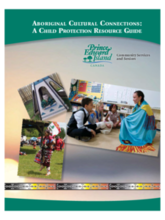This resource guide was developed by Child Protection Services of Prince Edward Island, Canada; the Department of Community Services and Seniors; and Prince Edward Island’s First Nations. It offers a fairly comprehensive guide to engaging with the Aboriginal community on Prince Edward Island, including a history of the Mi’kmaq people, a list of community-based services and organizations, an overview of Mi’kmaq spirituality, a guide to aboriginal culture (including views on parenting), a description of cultural practices and beliefs, an introduction to the Mi’kmaq language, a history of the residential schools for Mi’kmaq children, an outline of Mi’kmaq’s governance and identity, and additional resources.
According to this guide, the residential school system was created in the 1850s, “based on the beliefs that Aboriginal people were savages who needed to be assimilated into the mainstream European culture.” There were residential schools like this in nearly every province in Canada and the last of these schools did not close until 1996. Prince Edward Island did not have a residential school and, therefore, Aboriginal children were sent to schools in other provinces. Though the Canadian government issued a formal apology for the residential school system, the abuses and trauma suffered by the children and the communities have had a lasting impact. An estimated 50,000 children died in these residential schools during their operation and the removal of Aboriginal children from their communities led to often irrevocable cultural breakdown. This guide provides a timeline of the residential school system in Canada, as well as a spotlight on a particular residential school in another province and day schools on Prince Edward Island.
The guide also sheds light on what is called “The 60’s Scoop,” a phenomenon that began in the 1960s, continuing to the mid 1980s, in which Canada saw the largest numbers of adoptions of Aboriginal children, who were “scooped from their homes and communities without the knowledge or consent of families and bands.” “Many First Nations believed that in cases where consent was not given, government authorities and social workers acted under the generalized discriminatory assumption that Native people were culturally inferior and unable to adequately provide for the needs of their children.”

